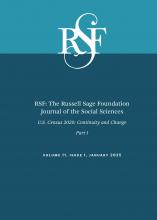Research Article
Open Access
Ethnoracial Transformations? Linking Administrative Data to Explain Changes in Identification
John Anders, Mary E. Campbell, Craig Wesley Carpenter, Luna Chandna
RSF: The Russell Sage Foundation Journal of the Social Sciences January 2025, 11 (1) 65-84; DOI: https://doi.org/10.7758/RSF.2025.11.1.04
John Anders
aAssistant professor in the Department of Economics at Trinity University, San Antonio, Texas, United States
Mary E. Campbell
bProfessor in the Department of Sociology at Texas A&M University and director of the Texas Federal Statistical Research Center, United States
Craig Wesley Carpenter
cAssistant professor in the Department of Agricultural, Food, and Resource Economics at Michigan State University, United States
Luna Chandna
dGraduate student in the Department of Sociology at Texas A&M University, United States

REFERENCES
- ↵
- Agadjanian, Alexander
- ↵
- Alba, Richard
- ↵
- Almond, Douglas, and
- Janet Currie
- ↵
- American Community Survey
- ↵
- Bialik, Kristen
- ↵
- Bond, Brittany,
- David Brown,
- Adela Luque, and
- Amy O’Hara
- ↵
- Breen, Casey F
- ↵
- Brown, Hana E.,
- Jennifer A. Jones, and
- Andrea Becker
- ↵
- Campbell, Mary E
- ↵
- Campbell, Mary E
- ↵
- Campbell, Mary E., and
- Christabel L. Rogalin
- ↵
- Chetty, Raj,
- John Friedman,
- Nathaniel Hilger,
- Emmanuel Saez,
- Diane Whitmore Schanzenbach, and
- Danny Yagan
- ↵
- Chetty, Raj,
- Nathaniel Hendren,
- Patrick Kline, and
- Emmanuel Saez
- Compton, Elizabeth,
- Michael Bentley,
- Sharon Ennis, and
- Sonya Rastogi
- ↵
- Davenport, Lauren
- ↵
- Doyle, Jamie Mihoko, and
- Grace Kao
- ↵
- Duncan, Brian, and
- Stephen J. Trejo
- ↵
- Duncan, Brian, and
- Stephen J. Trejo
- ↵
- Edmonston, Barry,
- Sharon M. Lee, and
- Jeffrey S. Passel
- ↵
- Farley, Reynolds
- ↵
- Feliciano, Cynthia, and
- Rubén G. Rumbaut
- ↵
- Fischer, Claude S., and
- Michael Hout
- ↵
- Hillygus, D. Sunshine,
- Norman H. Nie,
- Kenneth Prewitt, and
- Heili Pals
- ↵
- Irizarry, Yasmiyn,
- Ellis P. Monk Jr.., and
- Ryon J. Cobb
- ↵
- Jones, Nicholas,
- Rachel Marks,
- Roberto Ramirez, and
- Merarys Rios-Vargas
- ↵
- Kayyali, Randa
- ↵
- Lee, Jennifer, and
- Frank D. Bean
- ↵
- Lieberson, Stanley, and
- Mary C. Waters
- ↵
- Liebler, Carolyn A.,
- Renuka Bhaskar, and
- Sonya R. Porter (née Rastogi)
- ↵
- Liebler, Carolyn A.,
- Sonya R. Porter,
- Leticia E. Fernandez,
- James M. Noon, and
- Sharon R. Ennis
- ↵
- Lujan, Carol Chiago
- Massey, Catherine G.,
- Katie R. Genadek,
- J. Trent Alexander,
- Todd K. Gardner, and
- Amy O’Hara
- ↵
- Massey, Catherine G., and
- Amy O’Hara
- ↵
- Mathews, Kelly,
- Jessica Phelan,
- Nicholas A. Jones,
- Sarah Konya,
- Rachel Marks,
- Beverly M. Pratt,
- Julia Coombs, and
- Michael Bentley
- ↵
- Newby, C. Alison, and
- Julie A. Dowling
- ↵
- Perlmann, Joel
- ↵
- Pickett, Robert E.M.,
- Aliya Saperstein, and
- Andrew M. Penner
- ↵
- Porter, Sonya R.,
- Carolyn A. Liebler, and
- James M. Noon
- ↵
- Rodriguez, Clara
- ↵
- Roth, Wendy
- ↵
- Saperstein, Aliya, and
- Aaron Gullickson
- ↵
- Saperstein, Aliya, and
- Andrew M. Penner
- ↵
- Snipp, C. Matthew
- ↵
- Taylor, Evan J.,
- Bryan Stuart, and
- Martha Bailey
- ↵
- U.S. Census Bureau
- ↵
- U.S. Census Bureau
- ↵
- Vargas, Nicholas
- ↵
- Vargas, Nicholas, and
- Kevin Stainback
- ↵
- Ventura, Ilana, M. and
- René D. Flores
- ↵
- Wagner, Deborah, and
- Mary Layne
- ↵
- Waters, Mary C
In this issue
Ethnoracial Transformations? Linking Administrative Data to Explain Changes in Identification
John Anders, Mary E. Campbell, Craig Wesley Carpenter, Luna Chandna
RSF: The Russell Sage Foundation Journal of the Social Sciences Jan 2025, 11 (1) 65-84; DOI: 10.7758/RSF.2025.11.1.04





